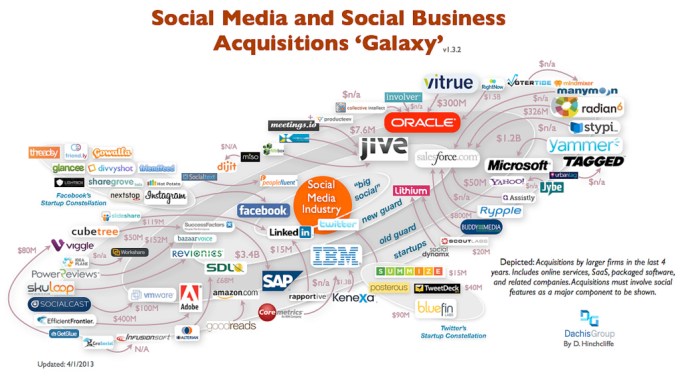You’ll be forgiven if you missed it, but lost in the avalanche of this year’s tech news, enterprise social software made an impressive comeback. Led by products like Slack, Workplace by Facebook and Microsoft Teams, a software category that had been languishing for the last several years, suddenly came alive.
A decade ago, as social software emerged, it was coined Enterprise 2.0 to describe products based on Web 2.0 consumer tools like blogs and wikis, which were making their way into business and attempting to transform the way employees communicate and collaborate. An industry developed with early companies like Yammer, Jive and Socialcast (to name but a few examples).
Jive was the only pure Enterprise 2.0 player to go public, IPOing in 2011, but there was also the inevitable consolidation as companies were sold. VMware bought Socialcast in 2011. Microsoft bought Yammer for $1.2 billion in 2012 — and so it went, as the space lost momentum.

Enterprise social deal flow chart from 2012. Credit: Dion Hinchcliffe
Cut me some Slack
Then came the launch of Slack in 2013, and while we didn’t know it at the time, it would prove significant. A year after launch, the startup began attracting enormous chunks of funding — garnering more than $522 million in investment across four rounds between April 2014 and April 2016. In fact, the April, 2016 funding round was for $200 million on a $3.8 billion valuation. Today, they are up to 4 million active daily users (of which 1.25 million are paying).
That kind of growth tends to get noticed and some important companies were paying attention. In October, Workplace by Facebook, the company’s enterprise social application, opened for business. Facebook is hoping to differentiate itself by being the communications tool for the entire company, not just a limited set of knowledge worker teams within a company.
Not to be left out, Microsoft introduced Microsoft Teams in November. Teams is also a social tool, but unlike its competitors, which take a broader view of the enterprise social ecosystem, Microsoft is really focused on people communicating around Office 365 documents.
Why now?
While the first wave of tools had similar functionality to today’s, perhaps they came too soon for widespread enterprise adoption. Companies simply weren’t ready for this type of open communication. What’s more, many of them predated the rise of the smartphone, which has itself transformed enterprise software and communication. When you combine mobility with social software and the cloud — and a geographically dispersed workforce — it may simply be that the time has finally come for more widespread adoption of these kinds of tools.
Certainly Microsoft, which began merging Yammer with its popular SharePoint product right after buying it, recognized the advantages of collaboration. Teams is another attempt at building that kind of community around Office 365, which was still in its earliest stages of development in 2012. As for Facebook, it simply didn’t have the resources in the first wave to even think about the enterprise as a target — even though many of the early products were billed as “Facebook for the enterprise.” Today, with so much more money and engineering talent, it can more easily turn its attention to this market.
Mobile, social and the cloud have been connected from the start, and perhaps all of these companies see a market that’s more open to communications and collaboration tools than they were the first time around. Some heavy hitters are clearly betting that’s the case.

